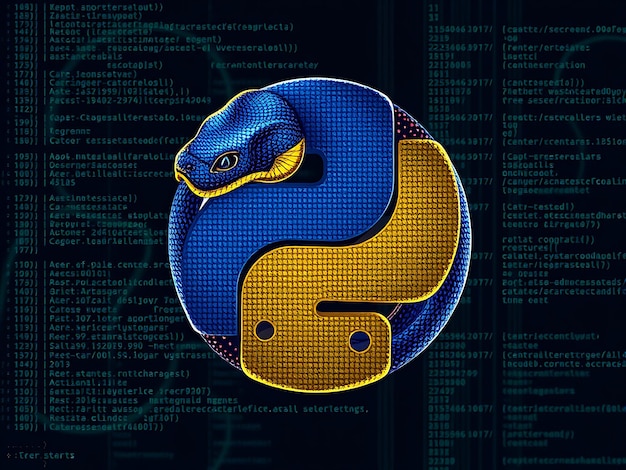Are you struggling to make your Python code more efficient and manageable?
If so, it’s time to dive into the world of object-oriented programming (OOP).
OOP in Python isn’t just a technique; it’s a mindset that transforms your approach to coding.
With fundamental concepts like encapsulation, inheritance, abstraction, and polymorphism, you’ll learn to structure your code in a way that promotes reuse and clarity.
Join us as we unravel how mastering these principles can empower your coding skills and elevate your programming projects to new heights.
Object-Oriented Programming in Python: An Overview
Object-oriented programming (OOP) in Python structures code by grouping related data and behaviors into objects.
Classes act as blueprints that define the attributes and methods of the objects created from them.
Central to OOP are four key concepts:
-
Encapsulation: This principle involves bundling data and methods that operate on that data within a class. It restricts direct access to some of the object’s components, creating a protective barrier. Access modifiers can determine the visibility of attributes and methods.
-
Inheritance: Inheritance allows one class (the child class) to inherit attributes and methods from another class (the parent class). This promotes code reuse and the creation of a logical hierarchy between classes.
-
Abstraction: Abstraction focuses on exposing only the necessary details to the user while hiding the complex implementation. It simplifies interface complexity and allows developers to concentrate on interacting with objects rather than their internal workings.
-
Polymorphism: Polymorphism enables methods to perform differently based on the object context that invokes them. This can occur through method overriding or overloading, allowing for adaptable interfaces.
These OOP concepts not only enhance code maintainability and readability but also lay the foundation for scalability in software development.
The utilization of these principles makes Python a versatile language, with its OOP features applicable across multiple programming languages and paradigms. Understanding and implementing these concepts in Python can significantly improve your object-oriented programming skills and facilitate the development of robust software applications.
Definiowanie klas i obiektów w Pythonie
Klasy w Pythonie służą jako plany do tworzenia obiektów.
Atrybuty klasy są inicjowane w metodzie __init__(), która działa jako konstruktor.
Metoda __init__() przypisuje wartości do atrybutów instancji, pozwalając na stworzenie unikalnych obiektów z danymi.
Na przykład, dla klasy Samochód, możemy zdefiniować atrybuty, takie jak marka i rok:
class Samochód:
def __init__(self, marka, rok):
self.marka = marka
self.rok = rok
W tym przykładzie self odnosi się do bieżącej instancji klasy.
Oznacza to, że self.marka i self.rok są atrybutami instancyjnymi, które będą różne dla różnych obiektów.
Tworzenie obiektów z tej klasy jest prostą czynnością.
Można to zrobić za pomocą:
moj_samochód = Samochód("Toyota", 2020)
Teraz moj_samochód jest obiektem klasy Samochód, przechowującym specyficzne dane: markę “Toyota” i rok “2020”.
Atrybuty klasy (znane również jako zmienne klasowe) są wspólne dla wszystkich instancji danej klasy.
Natomiast atrybuty instancji są unikalne dla każdego obiektu.
Na przykład, jeśli dodamy do klasy atrybut klasy, jak liczba_kół, to każda instancja będzie miała dostęp do tej samej wartości.
Jeśli chcemy dodać metodę do klasy, to również możemy to zrobić:
class Samochód:
def __init__(self, marka, rok):
self.marka = marka
self.rok = rok
def przedstaw(self):
return f"Samochód to {self.marka} z roku {self.rok}."
Obiekt można teraz wykorzystać do wywoływania tej metody, uzyskując dostęp do swoich atrybutów.
Wszystkie te aspekty sprawiają, że programowanie obiektowe w Pythonie jest wydajne i elastyczne.
Understanding Inheritance in Python OOP
Dziedziczenie w Pythonie to istotny koncept w programowaniu obiektowym, który pozwala na tworzenie nowych klas na podstawie istniejących.
Dzięki dziedziczeniu, klasa dziecka może przejąć atrybuty i metody klasy rodzica.
Promuje to ponowne wykorzystanie kodu i redukcję duplikacji, co jest kluczowym elementem w programowaniu.
Istnieją dwa główne typy dziedziczenia: dziedziczenie pojedyncze (single inheritance) i dziedziczenie wielokrotne (multiple inheritance).
W dziedziczeniu pojedynczym klasa dziedziczy z jednej klasy rodzica, co ułatwia zrozumienie hierarchii klas.
Na przykład:
class Zwierze:
def dzwiek(self):
return "Zwierzę wydaje dźwięk."
class Pies(Zwierze):
def dzwiek(self):
return "Hau hau!"
W tym przykładzie klasa Pies dziedziczy metodę dzwiek z klasy Zwierze, a następnie ją nadpisuje.
Z kolei w dziedziczeniu wielokrotnym klasa dziecka może dziedziczyć z kilku klas rodzica:
class Przyjaciel:
def przywitaj(self):
return "Cześć, przyjacielu!"
class Pies(Zwierze, Przyjaciel):
def dzwiek(self):
return "Hau hau!"
Tutaj klasa Pies dziedziczy z obu klas, Zwierze i Przyjaciel, co pozwala jej korzystać z metod z obu klas rodzica.
Dziedziczenie wielokrotne zwiększa elastyczność, jednak może prowadzić do komplikacji, takich jak diamentowy problem.
Znajomość dziedziczenia w Pythonie jest więc kluczową umiejętnością do tworzenia bardziej złożonych i modularnych aplikacji.
Exploring Polymorphism in Python
Polymorphism in Python allows methods to share the same name while behaving differently depending on the object context.
This capability enhances code flexibility and readability, promoting a code design that is cleaner and easier to maintain.
Method Overriding
One of the primary ways to achieve polymorphism is through method overriding.
In child classes, methods can be redefined to provide specific functionality while sharing the same name.
Here’s a basic example:
class Animal:
def sound(self):
return "Some sound"
class Dog(Animal):
def sound(self):
return "Bark"
class Cat(Animal):
def sound(self):
return "Meow"
animals = [Dog(), Cat()]
for animal in animals:
print(animal.sound())
Operator Overloading
Another form of polymorphism is operator overloading, allowing classes to define how operators behave with instances of a class.
This is achieved by defining special methods in the class.
For instance, here’s how you can overload the + operator for a simple Point class:
class Point:
def __init__(self, x, y):
self.x = x
self.y = y
def __add__(self, other):
return Point(self.x + other.x, self.y + other.y)
p1 = Point(1, 2)
p2 = Point(3, 4)
result = p1 + p2 # Uses __add__ method
Polymorphism through method overriding and operator overloading enables Python classes to redefine behavior, contributing to reusable code and better organization.
Encapsulation and Abstraction in Python OOP
Encapsulation principles in Python OOP are centered on bundling data (attributes) and methods (functions) within a class, restricting access to certain components to ensure internal state is protected from unintended interference or modification.
Access to class members can be controlled using different access modifiers:
- Public: Accessible from anywhere in the code.
- Protected: Accessible within the class and its subclasses.
- Private: Accessible only within the class itself.
For example, consider a class BankAccount:
class BankAccount:
def __init__(self, balance):
self.__balance = balance # Private attribute
def deposit(self, amount):
self.__balance += amount
def get_balance(self):
return self.__balance
In this example, the balance is a private attribute, accessible only through defined methods, promoting the encapsulation principle.
Abstraction in OOP is about exposing only the essential features of an object while hiding the complex implementation details. It simplifies the user interface and increases usability.
For instance, the BankAccount class provides simple methods to perform operations without exposing the underlying attributes or complex logic:
account = BankAccount(100)
account.deposit(50)
print(account.get_balance())
Here, the user interacts with high-level methods without needing to understand the intricacies of how the balance is managed internally.
Both encapsulation and abstraction contribute to secure and robust programming practices. They enhance software reliability by preventing direct access and modification of critical components, thereby facilitating maintainability and scalability in complex systems.
Practical Applications and Best Practices in OOP with Python
OOP facilitates the creation of maintainable and scalable applications, making it invaluable in various domains.
Real-World Applications of OOP
-
Web Development: Frameworks such as Django and Flask utilize OOP principles, enabling efficient management of web applications through reusable components and clear organization.
-
Game Development: The use of classes to define entities like players, enemies, and items allows game developers to build complex environments while maintaining clean and manageable code.
-
Data Analysis and Machine Learning: Libraries like pandas and scikit-learn leverage OOP to encapsulate data processing and model representation, promoting modularity and enhancing the reusability of code.
Best Practices in OOP
-
Follow Design Patterns: Familiarity with design patterns such as Singleton, Factory, and Observer can enhance code organization and maintainability. For instance, the Factory pattern allows the creation of objects without specifying the exact class of the object being created.
-
Adhere to PEP 8 Guidelines: By following Python’s style guide, developers ensure that code is readable and consistent, making collaboration easier and reducing the potential for errors.
-
Apply SOLID Principles: These five principles (Single Responsibility, Open/Closed, Liskov Substitution, Interface Segregation, and Dependency Inversion) promote better software design. For example, implementing the Single Responsibility Principle ensures that a class does one thing well, simplifying testing and debugging.
-
Emphasize Code Reusability: By designing classes that can be inherited or composed from existing ones, developers minimize redundancy. This allows for rapid development and easier evolution of applications.
Incorporating these practices leads to enhanced code robustness and reduced complexity, driving efficiency in software development.
Object-oriented programming in Python enables developers to create flexible, reusable code through the use of classes and objects.
This paradigm facilitates better organization of code and enhances collaboration among developers.
Key concepts, including inheritance and polymorphism, empower programmers to build robust applications.
By mastering object-oriented programming, developers can significantly improve their coding efficiency and project outcomes.
Embracing this powerful approach will undoubtedly pave the way for innovative solutions in Python development and foster a deeper understanding of programming principles.
FAQ
Q: What is object-oriented programming (OOP) in Python?
A: Object-oriented programming in Python structures code using classes as blueprints, grouping related data and behaviors into objects for modular and maintainable applications.
Q: How do you define a class in Python?
A: To define a class in Python, use the class keyword followed by the class name and a colon. Instance attributes are initialized within the __init__() method.
Q: How do you instantiate a class in Python?
A: Instantiating a class creates a unique object from the class blueprint, allowing you to store individual data using the class’s attributes and methods.
Q: What is the difference between class attributes and instance attributes?
A: Class attributes are shared across all instances of a class, while instance attributes are specific to individual objects, allowing for unique values.
Q: How does inheritance work in Python?
A: Inheritance allows a child class to inherit attributes and methods from a parent class, promoting code reuse and enabling functionality extension through the super() function.
Q: What is polymorphism in Python?
A: Polymorphism allows methods to use the same name but behave differently based on the object context, achieved through method overriding or overloading.
Q: What are encapsulation and its types in Python?
A: Encapsulation bundles data and methods within a class, restricting access. Members can be public, protected, or private, affecting visibility and functionality.
Q: What is data abstraction in Python?
A: Data abstraction focuses on hiding implementation details and exposing only necessary functionality, implemented through abstract classes and methods for cleaner design.
Q: What is the purpose of the __init__() method?
A: The __init__() method initializes instance attributes when a new object is created, enabling the assignment of specific values upon object instantiation.
Q: How does the self parameter function in methods?
A: The self parameter refers to the current instance of the class, allowing access to its attributes and methods; it must always be the first parameter in class functions.


